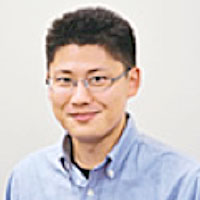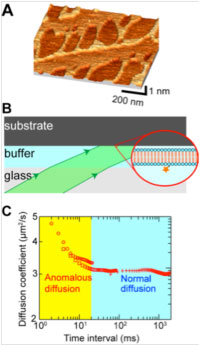Research highlights
Spatiotemporal behavior of lipids in a cell membrane model on nanostructured substrates
Lateral organization and diffusion of lipids and membrane proteins are crucial factors of biological reactions on cell membranes such as signal transduction and cell recognition. Various types and sizes of two-dimensional organizations, such as domains, clusters, and microcompartments, with scales from several nanometers to micrometers construct hierarchic structures in cell membranes.
Model lipid membrane systems mimicking the hierarchic structures on in-vivo scales are valuable for understanding the size-dependent functions of lipid organizations and how the lateral molecular transportation at microscopic regions propagates to macro scale.
Here, Ryugo Tero at EIIRIS and his colleagues have shown that a hierarchic structure with a comparable size in vivo can be introduced into an artificial lipid bilayer membrane using nanostructures on oxide surfaces as templates.
Lateral diffusion of lipid molecules in lipid bilayers on TiO2(100) (Figure 1A) and SiO2/Si substrates were directly observed by the single molecule tracking (SMT) method with diagonal illumination setup (Figure 1B). This diagonal illumination system achieved the SMT independent of the substrate transparency and refractive index, while conventional SMT is available on only glass or quartz.
The diffusion of lipid molecules in the lipid bilayers were observed at the time resolution of Δt=497 µs - Δt=30 ms, and the spatiotemporal dependence of the diffusion coefficients were visualized at the range of 1 ms to 1 s (Figure 1C). The atomic steps on TiO2(100) induced the diffusion barrier in the lipid bilayer, and the crossover from anomalous diffusion (= non-random diffusion) to random diffusion around 10 ms.
Fine architecture of nanostructures on solid substrates will lead to the control of the lateral structures and molecular transportation on the orders over 10 nm - µm, and of their hierarchic structures.
- Reference:
- Ryugo Tero, Gen Sazaki, Toru Ujihara, and Tsuneo Urisu
- Anomalous diffusion in supported lipid bilayers induced by oxide surface nanostructures
- Langmuir, Published on Web July 15, 2011.
- Digital Object Identifier (DOI): 10.1021/la201474h.
- Abstract: http://pubs.acs.org/doi/abs/10.1021/la201474h
- Electronics-Inspired Interdisciplinary Research Institute (EIIRIS), Toyohashi University of Technology, 1-1 Hibarigaoka, Tempaku-cho, Toyohashi, Aichi 441-8580, Japan
- EIIRIS URL: http://www.eiiris.tut.ac.jp/

Ryugo Tero

Enlarge Image
Figure caption
Figure 1. (A) Atomic force microscope image of the step-and-terrace TiO2(100) surface. (B) Schematic of diagonal illumination setup for single molecule tracking of lipid bilayers. (C) Temporal dependence of the diffusion coefficient in the lipid bilayer on TiO2(100).


